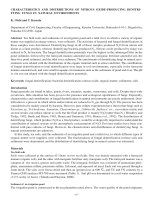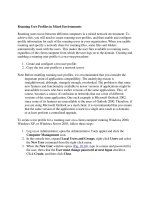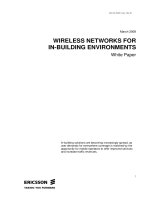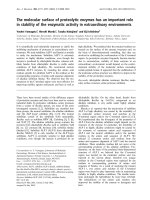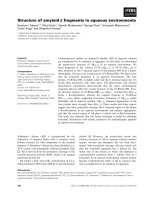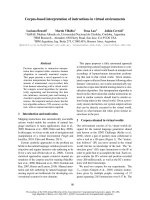Women leaders in chaotic environments
Bạn đang xem bản rút gọn của tài liệu. Xem và tải ngay bản đầy đủ của tài liệu tại đây (3.2 MB, 273 trang )
Lecture Notes in Social Networks
Şefika Şule Erçetin Editor
Women
Leaders
in Chaotic
Environments
Examinations of Leadership Using
Complexity Theory
Lecture Notes in Social Networks
Series editors
Reda Alhajj, University of Calgary, Calgary, AB, Canada
Uwe Glässer, Simon Fraser University, Burnaby, BC, Canada
Advisory Board
Charu Aggarwal, IBM T.J. Watson Research Center, Hawthorne, NY, USA
Patricia L. Brantingham, Simon Fraser University, Burnaby, BC, Canada
Thilo Gross, University of Bristol, Bristol, UK
Jiawei Han, University of Illinois at Urbana-Champaign, IL, USA
Huan Liu, Arizona State University, Tempe, AZ, USA
Raúl Manásevich, University of Chile, Santiago, Chile
Anthony J. Masys, Centre for Security Science, Ottawa, ON, Canada
Carlo Morselli, University of Montreal, QC, Canada
Rafael Wittek, University of Groningen, The Netherlands
Daniel Zeng, The University of Arizona, Tucson, AZ, USA
More information about this series at />
Şefika Şule Erçetin
Editor
Women Leaders in Chaotic
Environments
Examinations of Leadership Using
Complexity Theory
123
Editor
Şefika Şule Erçetin
Hacettepe University
Ankara
Turkey
and
International Science Association (ISCASS)
Ankara
Turkey
ISSN 2190-5428
ISSN 2190-5436 (electronic)
Lecture Notes in Social Networks
ISBN 978-3-319-44756-8
ISBN 978-3-319-44758-2 (eBook)
DOI 10.1007/978-3-319-44758-2
Library of Congress Control Number: 2016948768
© Springer International Publishing AG 2016
This work is subject to copyright. All rights are reserved by the Publisher, whether the whole or part
of the material is concerned, specifically the rights of translation, reprinting, reuse of illustrations,
recitation, broadcasting, reproduction on microfilms or in any other physical way, and transmission
or information storage and retrieval, electronic adaptation, computer software, or by similar or dissimilar
methodology now known or hereafter developed.
The use of general descriptive names, registered names, trademarks, service marks, etc. in this
publication does not imply, even in the absence of a specific statement, that such names are exempt from
the relevant protective laws and regulations and therefore free for general use.
The publisher, the authors and the editors are safe to assume that the advice and information in this
book are believed to be true and accurate at the date of publication. Neither the publisher nor the
authors or the editors give a warranty, express or implied, with respect to the material contained herein or
for any errors or omissions that may have been made.
Disclaimer: The facts and opinions expressed in this work are those of the author(s) and not necessarily
those of the publisher.
Printed on acid-free paper
This Springer imprint is published by Springer Nature
The registered company is Springer International Publishing AG
The registered company address is: Gewerbestrasse 11, 6330 Cham, Switzerland
To women and young girls
and to everyone who advocates for their
rights…
Şefika Şule Erçetin
Preface
The phenomenon of leadership is a virtually inexhaustible topic, even though it has
been treated in depth in many disciplines. This is why in leadership studies one still
encounters questions such as: What is leadership? Who is the leader in your team or
organization? Is leadership an innate gift? Can a leader bring about changes in a
community? What behavior is typical of a leader? Which style is characteristic of
leadership? Does woman leadership behavior differ from that of the opposite sex?
Relationships between women, chaos, complexity, network, and leadership are
among the most studied topics. These relationships are discussed in all chapters,
from different perspectives in the sense of global issues. The most significant theme
of the book is women leaders as public figures in different countries. The book
contains nineteen chapters divided into three sections. Part I consists of eleven
chapters on specific women leaders in various sectors and from different countries.
Part II has seven chapters on contemporary topics about women leadership with a
view to chaos and complexity. The last section contains the epilogue.
It is not so easy to clarify the significance of leadership, leadership behaviors, or
leadership types in a single book or a study. However, the aim was to pave the way
for further studies in the field and reveal multidimensional points of view by
gathering researchers from different disciplines all over the world. We hope that
reading this book will give its audience moments of peerless joy.
Ankara, Turkey
2016
Şefika Şule Erçetin
vii
Contents
Part I
Women Leaders Shape Past, Present and Future
Introduction . . . . . . . . . . . . . . . . . . . . . . . . . . . . . . . . . . . . . . . . . . . . . . . . .
Şefika Şule Erçetin
3
Emine Erdoğan: The Woman Power Behind
Recep Tayyip Erdoğan . . . . . . . . . . . . . . . . . . . . . . . . . . . . . . . . . . . . . . . .
Şefika Şule Erçetin and Şuay Nilhan Açıkalın
9
Foreign Policy Decision Making as a Chaotic Phenomenon:
Angela Merkel’s Foreign Policy Between 2005–2009 . . . . . . . . . . . . . . . .
Şuay Nilhan Açıkalın
21
“President Vigdís”: The End and the Beginning
of Women’s Agenda in Iceland . . . . . . . . . . . . . . . . . . . . . . . . . . . . . . . . .
Inga Minelgaite Snaebjornsson
35
Hazrat Aisha: In Terms of Religious, Authentic
and Didactic Leadership Characteristics . . . . . . . . . . . . . . . . . . . . . . . . . .
Mehmet Menteşe and Mehmet Cem Şahin
49
Oprah Winfrey’s Leadership Through Womanhood . . . . . . . . . . . . . . . .
Daniels Aide Okun
61
A Woman Leader in Ottoman History:
Kösem Sultan (1589–1651) . . . . . . . . . . . . . . . . . . . . . . . . . . . . . . . . . . . . .
Aylin Görgün-Baran
71
Rosa Louise Parks as a Quiet Leader Who Transforms
American Society Forever . . . . . . . . . . . . . . . . . . . . . . . . . . . . . . . . . . . . .
Kenan İli
87
Benazir Bhutto-Freedom and Chaos in Her Life . . . . . . . . . . . . . . . . . . .
İlknur Maya
99
ix
x
Contents
Maria Montessori’s Transformation of Special
Needs Education . . . . . . . . . . . . . . . . . . . . . . . . . . . . . . . . . . . . . . . . . . . . . 109
İbrahim Bello and İbrahim Bashar
Rebecca Kadaga’s Transformation of Uganda’s Parliamentary
System . . . . . . . . . . . . . . . . . . . . . . . . . . . . . . . . . . . . . . . . . . . . . . . . . . . . . 117
Sophie Nanyonga
Part II
Issues in Women Leadership
Women Leadership in Complex Social Media
and Social Networking Systems . . . . . . . . . . . . . . . . . . . . . . . . . . . . . . . . . 127
Şefika Şule Erçetin and Ssali Muhammadi Bisaso
Women’s Leadership in the Developing World: Learning
from the Past, Envisioning the Future . . . . . . . . . . . . . . . . . . . . . . . . . . . . 143
Purnima Mehta Bhatt
Women Empowerment for Promoting Rural Economy
in West Bengal: A Study on Pallimangal
(A Unit of Ramakrishna Mission Kamarpukur) . . . . . . . . . . . . . . . . . . . . 169
Dillip Kumar Das and Nilanjan Ray
A Complex Issue in the Turkish Education System:
Gender Imparity (2000–2015 Period) . . . . . . . . . . . . . . . . . . . . . . . . . . . . 185
Şefika Şule Erçetin and Kübra Sarıkaya Aydın
Gendered Leadership in Multinational Corporations:
Gendered Social-Organizations: An Analysis of a Gendered
Foundation in Organizations . . . . . . . . . . . . . . . . . . . . . . . . . . . . . . . . . . . 207
Ben Tran
The Role of Women Professionals in Transformation
of Higher Education for Sustainable Development . . . . . . . . . . . . . . . . . . 235
Ssali Muhammadi Bisaso
Women’s Challenges in Leadership . . . . . . . . . . . . . . . . . . . . . . . . . . . . . . 249
Mina Abbasiyannejad and Abu Daud Silong
Part III
Epilogue
Epilogue . . . . . . . . . . . . . . . . . . . . . . . . . . . . . . . . . . . . . . . . . . . . . . . . . . . . 259
Şefika Şule Erçetin
Glossary . . . . . . . . . . . . . . . . . . . . . . . . . . . . . . . . . . . . . . . . . . . . . . . . . . . . 271
Index . . . . . . . . . . . . . . . . . . . . . . . . . . . . . . . . . . . . . . . . . . . . . . . . . . . . . . 273
Contributors
Mina Abbasiyannejad Faculty of Educational Studies, University Putra Malaysia,
Selangor, Malaysia
Şuay Nilhan Açıkalın Middle East Technical University, Ankara, Turkey
Kübra Sarıkaya Aydın Hacettepe University, Ankara, Turkey
İbrahim Bashar Arabic and Islamic Education Board Sokoto, Sokoto, Nigeria
İbrahim Bello Shehu Shagari College of Education Sokoto, Sokoto, Nigeria
Purnima Mehta Bhatt History, Anthropology and Interdisciplinary Studies,
Hood College, Frederick, MD, USA
Ssali Muhammadi Bisaso Islamic University in Uganda, Mbale, Uganda
Dillip Kumar Das The University of Burdwan, Burdwan, India
Şefika Şule Erçetin Hacettepe University, Ankara, Turkey; International Science
Association (ISCASS), Ankara, Turkey
Aylin Görgün-Baran Hacettepe University, Ankara, Turkey
Kenan İli Hacettepe University, Ankara, Turkey
İlknur Maya Çanakkale Onsekiz Mart University, Çanakkale, Turkey
Mehmet Menteşe Hacettepe University, Ankara, Turkey
Sophie Nanyonga Republic of Uganda, Gazi University, Ankara, Turkey
Daniels Aide Okun Volgograd State Technical University, Volgograd, Russia
Nilanjan Ray Netaji Mahavidyalaya, Arambagh, India
xi
xii
Contents
Mehmet Cem Şahin Ankara University, Ankara, Turkey
Abu Daud Silong Faculty of Educational Studies, University Putra Malaysia,
Selangor, Malaysia
Inga Minelgaite Snaebjornsson School of Business, University of Iceland,
Reykjavík, Iceland
Ben Tran California School of Professional Psychology, Alliant International
University San Francisco, San Francisco, CA, USA
Part I
Women Leaders Shape Past,
Present and Future
Introduction
Şefika Şule Erçetin
Over the course of many years, at different places and times within my own country
and abroad, I have been given many opportunities to discuss and present lectures on
the topic of leadership. My discussants and audiences consisted of many people
with widely different interests in learning or extending their knowledge and
sharpening their skills in leadership. This goal has been pursued through courses,
conferences, symposiums, projects and various types of studies. The purpose of this
book is to share that exciting and instructive process with my readers. To that end,
we will begin with some of the most crucial questions and issues that arise in the
study of leadership, some universally fundamental ideas:
• Can an individual be born as a leader or become a leader only after some
experience?
• What is leadership and what are the assets of a successful leader? Is it possible to
determine a good or bad leader?
• What are the types and styles of leadership? Are there criteria that can unmistakably identify a good leader? What are the relationships between chaos,
complexity, network and leadership?
• And…of course, an age-old question. “Is leadership by women different from
that of men? If so, what are the criteria that explain this phenomenon? Or why
they do not?
Firstly, a long held assertion of mine is that “everyone is a potential leader”.
This is one of the issues that gave rise to the longest discussions in every group, and
everywhere I went. Emergence of potential is related to many variables such as
education, personal characteristics, individual awareness, and circumstances such as
Ş.Ş. Erçetin (&)
Hacettepe University, Ankara, Turkey
e-mail: sefi
Ş.Ş. Erçetin
International Science Association (ISCASS), Ankara, Turkey
© Springer International Publishing AG 2016
Ş.Ş. Erçetin (ed.), Women Leaders in Chaotic Environments,
Lecture Notes in Social Networks, DOI 10.1007/978-3-319-44758-2_1
3
4
Ş.Ş. Erçetin
an individual in an emergent potential can be differentiating in terms of effect size
and level during leadership processes. When I explain this, I immediately receive
responses such as How so? Did I? Me too? Did her/his?
We have all heard judgments made of the following nature: “He or she is a born
leader.” “No one who early in life fails to become a leader can later become a
leader.” “Not everyone can be a leader.” “Not everybody has leadership potential.”
Sometimes value judgments such as saying “I am a leader” are not compatible with
humility but can be in the background of these thoughts. At this point, I should
specify that many people see and define themselves as leaders after a certain time
and experience; people can say “Yes, also I am a leader, I am practicing leadership.” At the same time they may think “I am not aware of this leadership, nor can I
define this as leadership or humility. It is a different thing, but I AM a leader”.
Perhaps, in many cases, people perceive the leadership phenomenon as being a
place of much higher level from themselves and shape their places and positions by
customizing their own behavior. Many people think of education as consisting of
studies taking place in schools. They further conceive of education as a process in
which the leadership of some people who had not been educated in school could
educate their own children. Whereas education is a multidimensional process that
extends to all dimensions of life and are richer than we can evaluate in this limited
context.
At the same time, perhaps leadership is construed as a chosen result in reaching a
defined point, more than an ongoing process. This means that leadership cannot be
valued enough through only results, experiences or individual exertions. Rather,
leadership consists of expanding, growing and developing multidimensional processes such as a high level of self-awareness, continuous self-renewal, including the
development of an intense effort, in sacrifice, faith and determination. Moreover, as
always, there is no guarantee that these efforts will result in success; leadership
represents a challenge that includes many tests that can bring the satisfaction of
solving problems and the suffering of failing for those who do not.
Secondly, we continue pursuit of the questions “What is leadership?” and “Who
is a leader? How can we determine that somebody is or is not a leader? From my
own experience, I can say that these questions depend on how leadership is perceived and defined. Ok, then what IS leadership?” The question is open to discussion. We should be able to predict the countless and unlimited meanings that can
characterise this concept, in literature, and in everyday life. Almost everyone tries to
define leadership according to their own unique insights and perceptions. Defining
leadership is not that easy. We can easily compromise on a definition of leadership
as a concept that is dynamic in both theoretical and practical senses, evolving as
they proliferate and diversify installed meanings; some people give new meaning
with their styles, personalities create visions.
Then, who is a leader, how can we understand that somebody is a leader? We
can observe that, in many times and places, many people have attempted to answer
these questions in conflict with each other. In fact, in a sense, the answers are
simple and clear, if you perceive someone as a leader, that leader is defacto s/he.
You can decide somebody is a leader or not by taking a criterion according to your
Introduction
5
own meanings and qualities on the leadership concept. For instance, if you evaluate
leadership as a product of extrovert personality traits, you cannot perceive as a
leader somebody who has introverted personality traits. Or, if you think of leadership as a position or role that belongs to men, perhaps you cannot think of a
woman as a leader. You may simply be waiting for women to reveal their lack of
leadership or that they lack a profile specific to men in this regard.
It should not be forgotten that, in general, people easily perceive a man as a
leader but cannot perceive or accept a woman in that role. This fact and other
similar examples demonstrate that, in many parts of the world, men and women
cannot be adequately assessed for many people’s leadership potential evaluation.
All of this dynamic has revealed leadership assessment as only a perceptual
phenomenon.
We should always remember that an individual may not be perceived as a leader,
but that does not mean the person is NOT a leader. Considering that one can
perceive as a leader someone who others cannot see as a leader, we might consider
the effect of a broader, richer, more tolerant and deeper approach. Moreover, one
who cannot demonstrate a successful leadership profile in certain cases can
demonstrate successful leadership potential in different positions in another state.
Perhaps you may need to re-evaluate attributes, scope and a number of other
leadership criteria. No matter what field or level, female or male, criteria that you
use to evaluate whether someone is a leader or not, perhaps you may want to add a
few more criteria as follows;
• Is there a case in which a potential leader espouses an intellectual and philosophical background that s/he believes?
• Does s/he have a vision that has shaped the context of this case?
• Does this vision include,
– long-term inspired dreams, as well as short and medium term projects to
realize concrete achievements?
– clear, understandable ideas, emphasizing alternative policies and strategies?
– humanistic values that reveal new values with new achievements, leading the
future, justifying the lives of millions of people at least as strong as yours?
– is that the history which has already been written of the future you may have
in mind?
• Does s/he perceive leadership as a phenomenon in the integrity of a
leader-follower?
• Does s/he connect leadership to superior qualities of him/herself?
• Does s/he take into consideration the interests and needs of followers?
• Does s/he create common grounds and interactional environments to integrate
with followers?
• Did s/he know that every interaction creates an area defined as the edge of
chaos?
• Did s/he think that this area includes complexity, uncertainty and risk and at the
same time offers learning, development and creativity opportunities?
6
Ş.Ş. Erçetin
• Did s/he think that a leader is required to ensure leadership as strong and
orderly, not dispersed and disrupted, fluid and adaptable rather than stagnant and
locked?
• Does s/he feel or make others feel the impact of union, integrity, solidarity and
the common future of human society?
• Does s/he follow, investigate and take into account the results in the actions of
global, regional and local relationship-phenomenon patterns?
• Does s/he consider a multivariate and alternative management approach that
understands the difficulty of obtaining reliable and high probability predictions
for the future?
Of course these criteria are not limited to the list above. That list can be thought of
as a selection of questions that have been arisen through many years, many of
which have been widely adopted, all of which must be part of any leader’s
guidebook. As I said in the beginning, and feel that I need to say again, our agenda
does not emerge only from discussions, conflicts and a list of agreed criteria.
Thirdly, what are the types and styles of leadership? What management skills
are the most fruitful? What are the relationships among chaos, complexity, networking and leadership? Leadership styles and types… Democratic, autocratic,
laissez faire, cultural, visionary, charismatic, old school, transformational, perceptual, quantisation, plasma… Numerous types and styles of leadership can be
adopted. There exist an abundance of leadership styles and types that cannot be
adequately described in this introduction. However, the reader will find in this book
the names and writings of many authors who have written and lectured on this
abundance. Perhaps you will have the opportunity to understand more easily the
ideas of leaders that you know in terms of leadership types from different
perspectives.
More than that, I can say that relationships among chaos, complexity, networking and leadership are the most studied topics and need to be thoroughly
understood. As we observed our own behavior in our studies, we were able to see
that a chaotic atmosphere is not stable and repetitive. Mobility and dynamics are
results of multi-dimensional interactions among the factors within the system. In
general terms, “chaos is a state of disorder”. The common properties of chaos are
generally consciousness, complexity, connectivity, dissipation and emergence. The
most important one in terms of networks is connectivity. Chaos is a source of life, a
reality for organizations and people as living and self-organizing systems.
Leaders could potentially emerge who are able to face complexity simply and
openly, dynamically and timely, to be flexible and ready for transformation, able to
turn abundance into richness, are creative and participative and who turn uncertainty into certainty.
We also adopt the view that organizations are self-adapting chaotic systems.
When an organization envisions future and possible probabilities, it will challenge
change and uncertainty, and will make chaos an opportunity to succeed. Not only
are organizations but also societies are self-adapting chaotic systems. All in all, the
most important characteristics of complex adaptive systems are evolution of
Introduction
7
togetherness. To mention some properties of complex adaptive systems, we can
include the following: order, complexity, adaptable, unpredictable, self-organizing,
on the edge of chaos, the butterfly effect, and the red queen race. These characteristics are interrelated with each other in various combinations.
In this context, if we consider management of complex adaptive systems, we can
see that it is a combination of deliberate and emergent strategies. We think that
organizations, societies or groups can be productively studied and theorized about
in these terms. In this context, these are the fundamental assumptions that we adopt:
• CAS are made up of a multitude of agents, in a non-straightforward manner,
including people who are connected to and interact with each other, who
functionally and structurally make up a unit.
• They interact with themselves and with other complex adaptive systems, and
together these systems make up an environment that requires responsiveness
from all parties.
• They observe the consequences of their own actions as well as the stimuli that
enable those actions, and the responses of others to those actions.
Evolution works much faster when networks are decomposed. Chaos is an
indicator of a rich network connectivity. A slow evolutionary development is an
indicator of too much connectedness. This can be defined as performance decline.
When the performance of one agent is related to another, their performance may
become under optimal. To determine the best performing people in a network is a
high priority. If we can be effective in connectivity, information flow can happen
very fast. Because the rate of information flow allows us to learn from the events of
a case, it allows us to make better decisions.
Fourthly, is leadership of women different from that of men? Who are the
women leaders that have made a difference? Have it been noted that most of the
books and works on women leadership are biographies of women leaders? Also,
analyses of women leaders are generally made within the realm of a linear thinking
style. Despite significant obstacles and barriers for women who are ambitious for
leadership, there have been giant strides taken by women to arrest or undo the
scenario. Even those women who rose steadily through the ranks eventually crashed
into an impenetrable barrier while men continued to be more likely to be accelerated
into management positions by means of the ‘‘glass escalator’’. It is still crucially
necessary that women are helped upward and continuously supported in order to
demonstrate their abilities to attain key roles as leaders. Therefore, although societies have subjected women to some stereotypical tendencies engendering prejudices that identify women with particular occupational structures, there is a lot that
can be done to improve on the situation. The following are key ways of addressing
the concern in question:
• helping women to develop necessary confidence levels to pursue leadership
positions
• cultivating successful mentoring relationships for female professionals
• networking inside and outside of the office
8
Ş.Ş. Erçetin
• understanding men’s and women’s changing roles at work and at home and
• striking a balance between excelling at work and having a fulfilling personal life
(this is always a threat to women indeed)
Social factors constitute important obstacles as women assume managerial tasks.
Changes in the social structure have been too slow to place them in managerial
positions for adequately long periods. These periods are crucial to develop women
leaders in qualities that are proactive. They must have the opportunity to prove they
are adaptable, able to negotiate, good at observation, focused, self-confident,
respected, self-promoting, outspoken and authentic.
Accordingly, not many studies have explored women leadership and leaders in
an expansive mode, bringing on board their approach to leadership and the adaptation to the demands of chaotic environments from which they lead. Many
questions have been asked about womens’ opportunities. You can find the answer
to these questions in this book. Enjoy it…
Emine Erdoğan: The Woman Power
Behind Recep Tayyip Erdoğan
Şefika Şule Erçetin and Şuay Nilhan Açıkalın
Abstract In the last 13 years, Turkey’s economic and political sphere has been
transformed. The leader of this transformation was Recep Tayyip Erdoğan, who
was our Prime Minister before becoming the first directly elected President of our
Republic. There is a very fascinating story behind his success from his childhood
until today. There is no doubt that his wife, Emine Erdoğan, has played a most
crucial role in his political life and transformation of society. Although she was
never more visible than her husband, her lifestyle and vision has been a role model
for most Turkish women. This chapter is dedicated to Emine Erdoğan who composed her unique and honorable written interview particularly for this book.
Keywords Recep Tayyip Erdoğan
Á Emine Erdoğan Á AK Party
Women are quiet and powerful; women are deep and intense; women are modest and
wise. Emine Erdoğan is a very important actor who has embodied all of these virtues.
She has had a major impact on the achievements of the AK Party (Justice and
Development Party) by being the compelling voice of this epic raucous movement.
Emine Erdoğan is the last child of a family originally from Siirt, which is located
in the South East of Turkey and well known for its multicultural population. She
was born in 1955 in İstanbul. Since the early days of her childhood, she has been
persistent in social and political activities. A few examples are: The Women’s
Union and organizations and The Idealist Association of Science and Culture which
are said to constitute the starting point to Emine Erdoğan’s social and political
activities.
Ş.Ş. Erçetin (&)
Hacettepe University, Ankara, Turkey
e-mail: sefi
Ş.N. Açıkalın
Middle East Technical University, Ankara, Turkey
e-mail:
Ş.Ş. Erçetin
International Science Association (ISCASS), Ankara, Turkey
© Springer International Publishing AG 2016
Ş.Ş. Erçetin (ed.), Women Leaders in Chaotic Environments,
Lecture Notes in Social Networks, DOI 10.1007/978-3-319-44758-2_2
9
10
Ş.Ş. Erçetin and Ş.N. Açıkalın
Indeed, while carrying out the work of this organization that shall form the
starting point of Emine Erdoğan’s social and political life, she will meet the most
important leader in the history of Turkish politics, Recep Tayyip Erdoğan and this
shall be the first step to a new and harder life shoulder to shoulder with him.
First Lady Emine Erdoğan both in Turkey and around the world is perceived
with great admiration and respected by many women as a “role model and a leader”
when it comes to being a woman, a wife and a mother. Mrs. Erdoğan is the wife of
Recep Tayyip Erdoğan who has won 9 elections in the last 13 years. On the 10th of
August 2014, he was elected by 51.8 % of the people’s votes to become the
president of the Republic and so Emine Erdoğan became the 12th first lady of the
Republic of Turkey.
Emine Erdoğan, with the love of her convictions, her patriotism and loyalty to
Turkey, to women and women’s rights, has adopted an attitude supporting her
spouse calmly and confidently, even in difficult times. Be it the already small
number of events attended deliberately because of the restriction of the headscarf
and despite all the outrageous behaviors, she has never entered any discussion or
participated in any disturbing behaviors. Those who witnessed the protests, be it
other supposedly male or female who do not share her opinions, have seen her as
tolerant and never deviating from her constant politeness.
The sections of this book contributed to the first female leaders in this book,
written with great modesty and to which she agreed to give an interview, is dedicated to First Lady Emine Erdoğan. Though she has participated in many different
studies, Mrs. Erdoğan gave and shared with us a written and unique interview that
left a mark on this topic.
First Lady Emine Erdoğan, during the written interview, shared with the readers
her valuable views and opinions on works related to the Idealist Women’s Union.
The author Şule Yüksel Şenler, contributed various components of the impact of the
work of marriage and, the happiest and the most difficult time, women’s social
movement and involvement in political life, projects and how the lives of women
changed during the AK Party period.
1 Honorable First Lady, as Idealist Women’s Union,
What Would You Say About the Output in Terms
of Civil Society Organizations that Take Place? How Do
You Assess the Impact on Women of Such Institutions
to Be Included in the Social and Political Life
in Turkey?
As you know, we are part of a civilization; life is not only about or between men
and women with a perspective that separates each other with sharp borders.
For us life is shared with the sweet and the bitter sides. Men and women in
harmony with each other, cooperating and shouldering the burden of life. For
Emine Erdoğan: The Woman Power Behind Recep Tayyip Erdoğan
11
example, ‘working woman’ became more widespread during the post-industrial
revolution because women in the traditional World were also an essential part of the
production cycle, like men were. In the garden, the farm, the family members
worked in the studio together, sweated together. I mean woman was a natural part
of the social life. Both women, as well as men associated to certain principles and
had manners. But the conditions that modernity brought to us disturbed the balance
between men and women. Men became relieved from almost all the domestic roles,
and women were forced to work in factory and at home. Her workload was
increased. Private-public distinction appeared in the area during this period. Formal
conditions imposed to exist in the public domain, particularly for veiled women
were utterly compelling. Religious women who wish to be visible in social life
while having certain values faced obstacles in public sphere. Women were isolated
from social life. Wearing the veil did cause great controversy in the public sphere.
When you browse through the Turkish press archive, you will see how much of this
issue was such a controversy. Living in accordance to the principles of Islam in a
modern world has been a very large part of particularly religious and conservative
movements. Great intellectual activity in conservative communities occurred since
the 1960s. Names such as Şule Yüksel Şenler played an instrumental part in the
intellectual development of women. Periodicals, conversation circles made up an
important part of our social and intellectual life. These activities, as in the world of
politics and media, have shaped the civil society. Already-in-motion associations
such as Idealist Women’s Association consisted of women with such problems.
These associations and wisdom centers they had religious identity drawing strength
from each other to the exclusion of women from public area. On the one hand while
fighting impositions and on the other hand, they promoted the spirit of solidarity
and culture from the foundation.
Today, especially those gains made in the first nucleus of the religious women
would say it is a very important place. Currently, we have seen many women in the
political arena or in different tasks themselves raised here. Social experience gained
in this process was prepared to speed up new tasks. The opportunity was there to
introduce oneself to the community.
2 Şule Yüksel Şenler, Who Has a Leading Role Among
Religious Women Writers, What Is Her Impact in Your
Life?
I met with Şule Yüksel Şenler during my teenage years. She was a role model for
religious women during that period. Educated, urban, cultural and a unique religious identity, she did create a synthesis in herself. From Headscarf to the courtesy
to match the form of her accumulation on religious and social issues to the oratory
was the model for us. Her model of wearing headscarf was both stylish and modern,
12
Ş.Ş. Erçetin and Ş.N. Açıkalın
both owned entity. Lectures she gave in Anatolia, were instrumental in realizing the
traditional Anatolian women.
All the salons of the cities that she went to were overcrowded. But the religious
issue has been discussed behind closed doors for decades, the identity of a society
deprived, courageously voiced the core issues in our public auditorium. Moreover,
she did it as a woman. But what the essentially interesting part was that the
audience of Şule Yüksel Şenler was not just women who had distinguished
themselves with religious identity as women, but also men were. Şenler was also a
charismatic character for conservative men. This is not a very common condition in
the history of the Republic of Turkey. The number of women that have affected the
masses in this way does not exceed the fingers of a hand when counted altogether.
Şenler had an impact on three generations. A leading role in the understanding of
the authentic religious comment under the shadow of some of the traditional
understanding, and while doing this, tools such as art was effectively used. In 1977,
she wrote the novel ‘Huzur Sokağı’ (Peace Street) which influenced into the lives of
people whether or not they liked the literature. Indeed, the novel was such that even
the women who had never read a novel in their lifetime started reading the novel.
Many parents gave their offspring the name of the main character. She was inspired
from the sincere and friendly ties that exist in Islamic culture and traditions. One of
the most impressive sides of Şule Yüksel was her using of the poetry and scientific
knowledge with religious references in her speeches. The portrait of this religious
women writer maintains its influence since that day.
In my personal life, it has had a significant impact on me that I could find the
courage to use headscarf in a modern and urban lifestyle. Indeed, considering the
cultural conditions of the period to render, as a faithful regular prayer as a young
girl like me, even as a religious duty to wear headscarf in the city life was quite
difficult.
3 How Have the Social Activities that You Carry Out
Been Affected by Your Marriage with the President?
My husband’s life is a life dedicated to the cause. He made this commitment and
also had his family as companion. Being the wife of a leader, of course, also has
important responsibilities on me. While trying to enhance myself intellectually and
in faith, also I tried to make an extra effort in the fields where I can contribute to the
society. Intellectually and after all, we were never such people who pursued only
their own personal wellbeing.
It was in fact this sense of togetherness that made me and Tayyip Bey come
together. Therefore, my marriage, the social awareness that I brought from my
family, altruism and other resembling feelings helped to nurture brand new environments that I came across. I had the opportunity to meet with different social
Emine Erdoğan: The Woman Power Behind Recep Tayyip Erdoğan
13
circles, which has enriched my human experiences. Tayyip Bey’s politics and life
experience have always been enlightening for me.
He always gave value to my conscience and he has always expressed himself in
this subject. Certainly, the changes in the political activities of my husband have
had an impact on my life. For example, during the period of his mayorship, I had to
leave the woman branch of political party organization where I used to serve with
great enthusiasm. In fact, the tasks in the party organization were like a social
laboratory and we made sure that we took all the responsibilities to act as required.
During this period, our lives were not only ours anymore; and they were shaped
with duties and responsibilities from the public.
We burdened ourselves with the burdens of the society. As if we were
responsible for the snow that falls on the people and for the rain that falls on them
too. We didn’t put distance ourselves from the society. During our service at
İstanbul Metropolitan Municipality and the Prime Ministry we used to live in
Kasımpaşa, İstanbul, and in Keçiören a modest neighborhood in Ankara, which was
intertwined with the public in an ordinary apartment. We were in touch with each
other and with the people going and coming out of the neighborhood. We didn’t
isolate ourselves from the society. This style of leadership was an example to our
children. Intertwined with the society, on the side of Righteous…. Each of our
individual lives is filled with effort that flows to the same river. Besides it is a big
chance for us that our children also have those shared awareness.
4 It Is Known that You Are the Biggest and Most
Courageous Friend and Supporter of Your Spouse.
What Are the Happiest and Saddest Times You Had
to Live with as a Wife of the World Leader?
Of course, we have had many happy and difficult times. Mankind in general tend to
forget about the pain and sadness and try to remember the happy memories. Even
though we accumulate, joyful moments in life, hardships can leave a bigger trail on
our souls. I can say that there is an issue primarily in hard times that I am still
touched when I called upon.
If you remember, in 2012, a huge humanitarian crisis in Myanmar occurred. The
Muslim people were under pressure to a point that would cause harm to their
dignity. Thousands of people were being killed, their homes were attacked, they
faced with the risk of deportation. Indeed, more than 1000 Muslim lives were lost,
100 thousands of people were left homeless. At the time, Foreign Minister
Davutoğlu, my daughter Sümeyye and I went to Arakan (Muslim populated territory of Myanmar). Despite the very serious security risks that we had seen in the
media, we would not do anything to stand in the face of what we had heard and
seen. Indeed, we encountered such views when we got there—People were thinking
14
Ş.Ş. Erçetin and Ş.N. Açıkalın
that death is the only way to emancipate. Which is not really possible to forget the
persecution caused by man.
The feelings of pain and sadness got entangled in this trip. People of Arakan
were on the streets while welcoming us as descendants of the Ottoman State. Our
convoy was stopped often, small letters were thrown in through the windows of our
cars showing their trust and gladness but in fact even if not everything was written
and told, their tears were telling us everything.
The real painful thing was not only in their material poverty but also rather by
the lack of ID, passports and right to movement, that means they were not considered as citizens. All these are still difficult to witness and have left deep scars in
my soul. From that visit if it had any consolation; we contributed in the opening of a
humanitarian aid corridor and we were able to make ourselves heard by the rest of
the world. Likewise, Somalia had a similar effect on me. In 2011, during the
presidency time of Tayyip Bey and some businessmen went on a trip to Somalia
and we were able to witness the hunger, drought, epidemics that affected the people
there. We were all very affected. Fortunately, this visit, both in Turkey and in our
close geography led to the start of major aid campaigns.
If you are sensitive to the suffering of human beings, no matter where in the
world you are, their pain will be like yours.
However the difficulty and the sadness that people live in their own country
touch the human being in a harder way. The prison days of my husband were not
only hard for me but also for my children. But the real thing that really makes us
upset was not the separation of an elder from the family but rather the elimination of
a person who aims were nothing more than to serve his country with political
maneuvers. Although the verdict given under unfair and arbitrary reasons, broke
our hopes for a democratic Turkey. The post period would be the start of a better era
for the country. Public confidence during this process was reinforced by Tayyip
Bey and he came out even stronger from every election. Our nation realized the
games that were played on the country. Therefore it opened a new page in our
history of democracy. To the one who said ‘You cannot even be “muhtar” (the
smallest elected representative of the local government)’, he won one out of every
two votes to make history and be the first elected President.
We, as Muslims, believe that there is a blessing in everything that happens.
Therefore, all I can say about happiness is together with the difficulties, we are
thankful for the blessings that Allah gives us. Despite all the problems that we
experienced, to see what his political movement during his leadership brought to
Turkey was the biggest happiness that I lived.
Emine Erdoğan: The Woman Power Behind Recep Tayyip Erdoğan
15
5 What Are Your Thoughts About the Challenges
and Hard Times When the Most Serious and Dense
Problems Related to the Participation of Women
in the Social and Political Life of Turkey?
The biggest obstacle towards the participation of women to the social life is, as I
mentioned in the beginning, the conditions developed against the women after the
industrial revolution. However, this was not happening only in Turkey, the same
conditions could be seen all over the world. The main problem of Turkey was the
top to down model of modernization process.
The Turkish modernization is connected to specific modal conditions. Turkish
society is formatted so to say by cutting it off from its tradition and culture. This, of
course brought a restless modernization story to open. Some parts of the society
were debarred from their rights. For example, the rights of election and being
elected by women were recognized in 1934. However, this right was kept deficient
for some woman in one dimension, head scarfed women who constitute the 60 % of
the community were able to gain the right of being elected in 2014, 80 years after
independence.
Turkey has been through very serious democratic problems for 90 years as it
was not easy to break the hegemony created by a very small minority in the nation.
The most problematic periods of course were the coup d’état periods during this
time being. Each military coup took Turkey back. Especially on the 28th of
February (it is still known as the postmodern coup d’état that oppressed the whole
segments of society and prevented access from basic rights). This process, of huge
injustice was done against the head scarfed women. The education rights of these
women were taken and some of them were fired from their jobs. The young girls,
who were admitted into the universities through passing the same exam with their
other mates, were sent back from the university. The first ranking students were sent
back from the stage by closing their mouths during the diploma ceremonies. Those
periods were indeed the most offended periods for Turkey. The only gain of this
whole process was that some of our head scarfed daughters turned these disadvantages into advantages. They learned foreign languages and improved themselves. The living example of ‘What doesn’t kill you makes you stronger’, was that
they learned to struggle and brought a mature challenging character out. Other than
that, these girls started changing their families too. If some of the conservative
families are not against the educating their daughters abroad today, the role of 28th
Feb experience is undeniable.
Fortunately, the AK Party has arranged a lot of democratic rights during the last
13 years and literally closed arena and recreated a new Turkey. Today, we have
veiled women in the parliament as well as they possess important jobs in the public
sphere.
